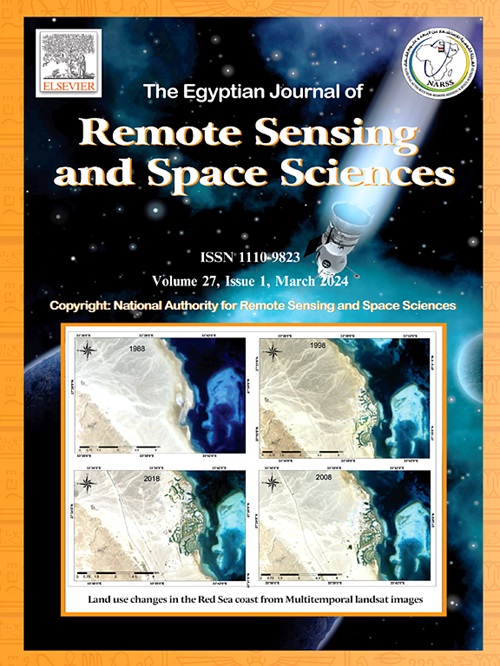New insights into the Menyuan Ms6.9 Earthquake, China: 3D slip inversion and fault modeling based on InSAR remote sensing approach
IF 3.7
3区 地球科学
Q2 ENVIRONMENTAL SCIENCES
Egyptian Journal of Remote Sensing and Space Sciences
Pub Date : 2025-01-27
DOI:10.1016/j.ejrs.2024.11.003
引用次数: 0
Abstract
Harnessing high-precision spaceborne InSAR data, this study investigates the seismic impacts of the Ms 6.9 Menyuan earthquake in Qinghai, China, on January 8, 2022. The earthquake occurred at the intersection of the Lenglongling (LLLF) and Tuolaishan (TLSF) faults within the Qilian Haiyuan Fault (QL-HYF) zone, causing extensive infrastructure damage but no fatalities. Previous studies explored the step-over rupture zone and slip distribution of the Menyuan event but often relied on oversimplified rectangular dislocation models, insufficient for capturing complex fault ruptures. This simplification impedes accurate representation of curved fault segments in the QL-HYF zone, leading to unclear slip distribution estimates, particularly at the transition from LLLF strike-slip to TLSF thrust behavior. To address these limitations, this study employs a 3D triangulated angular dislocation slip-inversion approach in an isotropic half-space, enabling precise modeling of curved fault geometries. Leveraging Differential InSAR (D-InSAR) and Pixel Offset Tracking (POT), we reconstructed the earthquake’s 3D displacement field and extracted surface fault traces, informing our angular dislocation model for accurate coseismic slip distribution. Our results revealed significant horizontal displacement, with 38.5 cm of left-lateral movement accompanied by a 4 cm downward thrust. The slip model showed 2.7 m of slip along the LLLF and 0.8 m along the TLSF, concentrated at shallow depths between 2 and 7 km, highlighting surface rupture. The transition zone between the faults acted as a valve, modulating rupture progression and controlling energy release. These findings refine the understanding of coseismic deformation and slip distribution, supporting seismic hazard mitigation and emergency response strategies.
中国门源Ms6.9地震的新认识:基于InSAR遥感方法的三维滑动反演和断层模拟
利用高精度星载InSAR数据,研究了2022年1月8日发生在中国青海门源的6.9级地震的地震影响。地震发生在祁连海源断裂(QL-HYF)带内冷龙岭(LLLF)和沱来山(TLSF)断裂的交汇处,造成了广泛的基础设施破坏,但没有人员死亡。以往的研究对门源事件的跨台阶破裂带和滑动分布进行了探索,但往往依赖于过于简化的矩形位错模型,不足以捕捉复杂的断层破裂。这种简化阻碍了QL-HYF带弯曲断层段的准确表示,导致滑动分布估计不明确,特别是在从LLLF走滑到TLSF逆冲行为的过渡阶段。为了解决这些限制,本研究在各向同性半空间中采用了三维三角角位错滑移反演方法,从而能够精确地模拟弯曲断层几何形状。利用差分InSAR (D-InSAR)和像素偏移跟踪(POT),我们重建了地震的三维位移场,并提取了地表断层的轨迹,为我们的角位错模型提供了准确的同震滑动分布信息。我们的研究结果显示了显著的水平位移,38.5厘米的左侧移动伴随着4厘米的向下推力。滑移模型显示,沿中低陆面和TLSF分别有2.7 m和0.8 m的滑移,集中在2 ~ 7 km的浅层深度,地表破裂突出。断层间的过渡带起着调节破裂进程和控制能量释放的阀门作用。这些发现完善了对同震变形和滑移分布的理解,为地震灾害缓解和应急响应策略提供了支持。
本文章由计算机程序翻译,如有差异,请以英文原文为准。
求助全文
约1分钟内获得全文
求助全文
来源期刊
CiteScore
8.10
自引率
0.00%
发文量
85
审稿时长
48 weeks
期刊介绍:
The Egyptian Journal of Remote Sensing and Space Sciences (EJRS) encompasses a comprehensive range of topics within Remote Sensing, Geographic Information Systems (GIS), planetary geology, and space technology development, including theories, applications, and modeling. EJRS aims to disseminate high-quality, peer-reviewed research focusing on the advancement of remote sensing and GIS technologies and their practical applications for effective planning, sustainable development, and environmental resource conservation. The journal particularly welcomes innovative papers with broad scientific appeal.

 求助内容:
求助内容: 应助结果提醒方式:
应助结果提醒方式:


